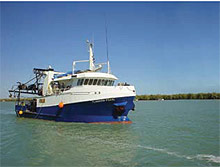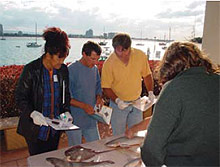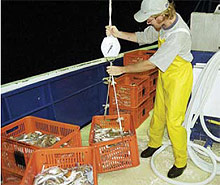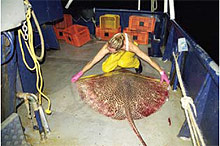
|
||||||||
|
The Northern Prawn Fishery has been looking at ways to monitor large, ecologically important bycatch species such as turtles, seasnakes and sawfish. Involving the fishers as “crew-member observers” to collect this information can be a cost effective way of monitoring bycatch. This is an inital finding of a three-year study of fishery-based and fishery-independent observation methods that will underpin a long-term bycatch monitoring and management programme for the fishery. CSIRO and the Australian Fisheries Management Authority (AFMA) are partners in the research, which has been funded by the Fisheries Research and Development Corporation (FRDC). Bycatch in the Northern Prawn Fishery includes fish, turtles, sharks and rays, and invertebrates (crabs, non-commercial prawns, sea-eggs, sponges and corals). Scientists need more information on these bycatch groups to determine which groups are at risk from trawling and to develop strategies that minimise their capture. |
 Bycatch reduction is an important management goal for Australia’s Northern Prawn Fishery. (courtesy CSIRO Marine and Atmospheric Research) |
As part of the study, crew member observers — mates, cooks and deckhands — and their skippers learned to record information on larger species groups including turtles, seasnakes, sawfish and sharks and rays and make estimates of total bycatch. They have been applying these skills at sea since 2003. “Crew member observer programmes are cost-effective and can provide the volume of observations needed to detect changes in the populations of these species groups,” Don Heales of CSIRO says. “But due to the demands of commercial fishing there are limits to the types of data they can collect. Given these constraints, they are best suited to recording interactions with the larger and easily processed bycatch species such as the turtles, sawfish and seasnakes.” Seasnakes can be identified with 97 per cent accuracy from photographs taken by crew-member observers. Thousands of seasnake records gathered during the study have been added to a database of their distribution and abundance. The information is contributing to an assessment of the vulnerability of seasnakes to trawling. Information gathered on potentially threatened sawfish species also has been collected by crewmember observers. This information is critical to bycatch management as sawfish are highly vulnerable to trawling and can be difficult to exclude through bycatch reduction devices. The study has also found that scientific observers play a critical role in validating fishery-based data collection. “Scientific observers have the flexibility to sample the many hundreds of smaller fish and invertebrate species that constitute the bycatch community,” Mr Heales says. “They also perform the more technical and time consuming tasks such as taking environmental measurements and carrying out small, onboard survival experiments on selected bycatch species.” The Northern Prawn Fishery is committed to establishing a long-term monitoring programme to gather accurate information required to assess the effects of fishing on bycatch — including any protected or potentially at-risk species — and to respond with management practices that meet national and international standards. Find out more |
|
- CSIRO Marine and Atmospheric Research
www.cmar.csiro.au - Fisheries Research and Development Corporation
www.frdc.org.au - Northern Prawn Fishery, Australian Fisheries Management Authority
www.afma.gov.au/fisheries/northern_trawl/northern_prawn
Acknowledgements
This information sheet has been complied using the expertise and support from CSIRO Marine and Atmospheric Research.
We would like to acknowledge DAFF, AFMA, FRDC, CSIRO and DEH for allowing us to use their images for Seaweek 2007 activities.



